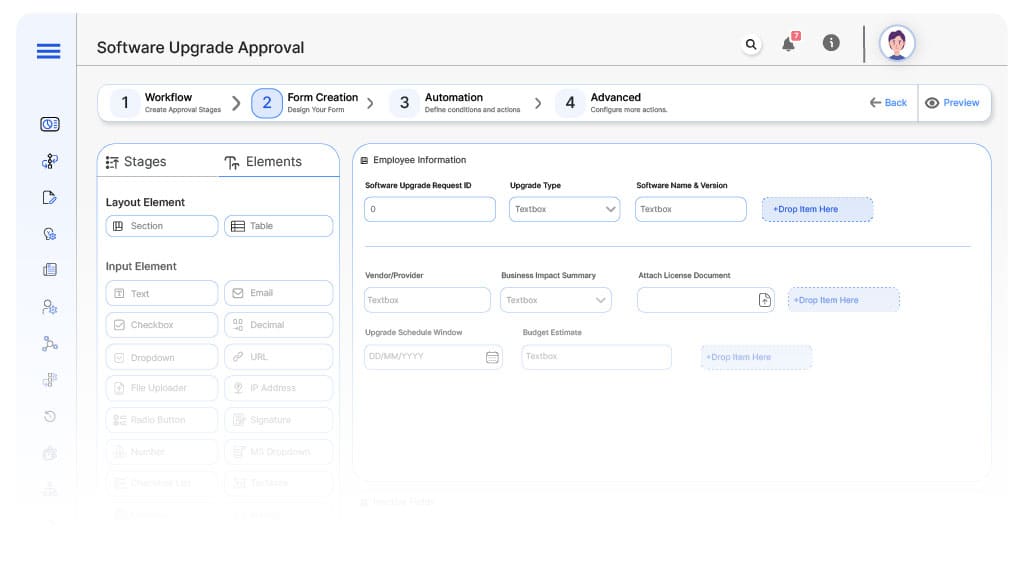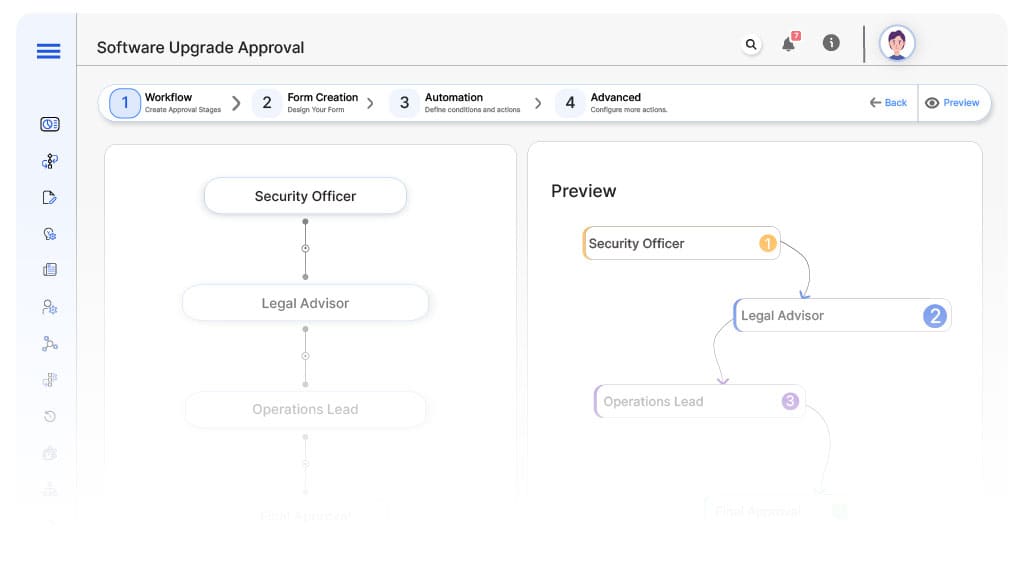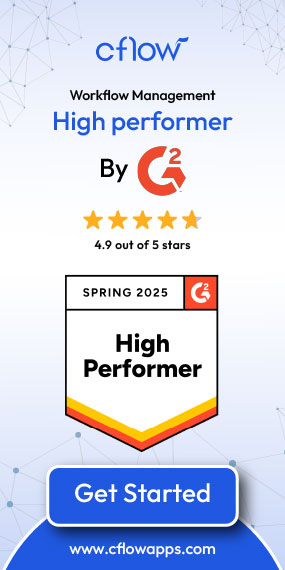- Cflow
- Software Upgrade Approval Automation
Software Upgrade Approval Automation

Clow Team

Software upgrades are critical to improving performance, patching vulnerabilities, and maintaining compliance. But without a controlled approval process, teams face risks such as security breaches, system incompatibility, regulatory lapses, and cost overruns. Recent industry research shows that nearly 60% of IT upgrade delays stem from disorganized approval chains and lack of visibility into impacted systems.
Without automation, IT managers, security officers, operations leads, legal teams, and finance departments struggle to coordinate reviews, manage documentation, and ensure timely rollouts. This guide walks you through exactly how Cflow automates Software Upgrade Approval Process, from initial submission to final deployment authorization.
What Is Software Upgrade Approval Process?
The Software Upgrade Approval Process is a structured workflow that governs how enterprise software changes, patches, updates, version releases, are reviewed, validated, approved, and implemented across systems.
This process ensures technical integrity, regulatory compliance, and operational stability before any upgrade goes live. It includes submission by IT, security risk review, legal compliance check, operations testing scope, and finance license validation.
Recent industry research shows that organizations with automated upgrade approval processes report 40% faster deployment times and 35% fewer system failures post-upgrade.
Why This Process Matters?
Security Risk Mitigation
Operational Continuity
Compliance Assurance
Budget Control
Scalability
Try Cflow for free, no credit card needed
Key Benefits of Automating Software Upgrade Approval with Cflow
- Centralized Request Portal: Cflow provides a structured form to capture upgrade scope, affected systems, risk level, and vendor details, ensuring no data is missed. Requestors can also attach supporting documentation like vendor SLAs, upgrade guides, or test results.This standardization ensures all necessary inputs are captured before routing begins.
- Dynamic Routing by Upgrade Type: Whether it’s a security patch or a full platform update, Cflow’s logic routes to security, legal, operations, and finance accordingly. Routing logic adapts based on system criticality, data sensitivity, and integration dependencies. Each stakeholder receives only the relevant upgrade requests for faster and focused review.
- Multi-Stage Approvals: Requests route sequentially or in parallel – IT initiates, Security checks risk, Legal reviews license terms, Operations validates rollout impact, and Finance clears budgets. Each stage has clearly defined responsibilities and deadlines to avoid bottlenecks.
Cflow logs all actions to maintain visibility into who approved what and when. - Real-Time Notifications: Automated alerts notify stakeholders at each stage, reducing follow-up cycles and speeding up decisions. Notifications can be customized by role, urgency, or pending duration. This ensures no request goes unnoticed and deadlines are consistently met.
- Audit Trail & Compliance Logs: Each approval, comment, and timestamp is recorded for auditors or internal governance reviews. Exportable logs can be filtered by upgrade type, system name, or user for reporting. This transparency supports ITSM policies and external regulatory audits.
- Version-Aware Forms: Forms can include software version numbers, vendor contracts, and scheduled deployment windows for complete transparency. Version tracking helps ensure that teams align on target releases and supported configurations. Attachments like changelogs or rollback plans can be included for context.
- Mobile Accessibility: Stakeholders can review, approve, or request changes on the go, ensuring upgrades move forward without delay. Mobile access enables timely decision-making across time zones and during field operations. Cflow ensures secure, role-based mobile interactions with real-time status visibility.
Get the best value for money with Cflow
User Roles & Permissions
IT Manager (Initiator):
- Responsibilities: Submits upgrade request with documentation on version change, vendor details, and impact analysis.
- Cflow Permission Level: Submit Form.
- Mapping: “IT Team.”
Security Officer:
- Responsibilities: Assesses vulnerability risks and cybersecurity implications of the proposed upgrade.
- Cflow Permission Level: Approve/Reject.
- Mapping: “Security Group.”
Legal Advisor:
- Responsibilities: Validates software license agreements, vendor terms, and regulatory adherence.
- Cflow Permission Level: Approve/Reject.
- Mapping: “Legal Group.”
Operations Lead:
- Responsibilities: Confirms upgrade impact on system performance, integration compatibility, and user access.
- Cflow Permission Level: Approve/Reject.
- Mapping: “Operations Group.”
Finance Controller (Final Approver):
- Responsibilities: Approves budget allocation, license renewal costs, and validates vendor invoice compliance.
- Cflow Permission Level: Approve/Reject.
- Mapping: “Finance Team.”
Discover why teams choose Cflow
Form Design & Field Definitions

Field Label: Software Upgrade Request ID
- Type: Autonumber
- Auto-Populate: Generated on submission.
Field Label: Upgrade Type
- Type: Dropdown (Security Patch, System Update, Version Upgrade, Compliance Fix)
- Logic/Rules: Determines approval flow routing.
Field Label: Software Name & Version
- Type: Date Picker
- Logic/Rules: Mandatory.
Field Label: Migration Scope Summary
- Type: Text
- Logic/Rules: Mandatory field for identification.
Field Label: Vendor/Provider
- Type: Text
- Logic/Rules: Mandatory.
Field Label: Business Impact Summary
- Type: Text Area
- Logic/Rules:Required for risk and operational assessment.
Field Label: Attach License Document
- Type: File Upload
- Logic/Rules: Mandatory if upgrade is vendor-provided.
Field Label: Upgrade Schedule Window
- Type: Date Picker
- Logic/Rules: Optional.
Field Label: Budget Estimate
- Type: Calculated Field
- Logic/Rules: Populated based on license renewal or contract terms.
Field Label: Security Risk Review Notes
- Type: Text Area
- Logic/Rules: Editable only by Security Officer.
Field Label: Legal Review Notes
- Type: Text Area
- Logic/Rules: Editable only by Legal Advisor.
Field Label: Operations Readiness Comments
- Type: Text Area
- Logic/Rules: Required before moving to Finance.
Field Label: Finance Approval Remarks
- Type: Text Area
- Logic/Rules: Final input field before closure.
Transform your Workflow with AI fusion
Approval Flow & Routing Logic

Submission → Security Officer
- Status Name: Pending Security Review
- Notification Template: “Security review needed for new upgrade request.”
- On Approve: Route to Legal Advisor.
- On Reject: Return to IT Manager.
- Escalation: Notify Security Head if not reviewed in 24 hours.
Security Officer → Legal Advisor
- Status Name: Pending Legal Review
- Notification Template: “Review vendor license and compliance terms.”
- On Approve: Route to Operations Lead.
- On Reject: Return to Security Officer.
- Escalation: Notify Legal Head in 24 hours.
Legal Advisor → Operations Lead
- Status Name: Pending Operations Validation
- Notification Template: “Validate readiness and system compatibility.”
- On Approve: Route to Finance Controller.
- On Reject: Return to Legal Advisor.
- Escalation: Alert Ops Director after 24 hours.
Operations Lead → Finance Controller
- Status Name: Pending Final Approval
- Notification Template: “Final budget and compliance check needed.”
- On Approve: Upgrade approved and workflow closes.
- On Reject: Return to Operations Lead.
- Escalation: Notify CFO if delayed beyond 24 hours.
Finance Controller → Final
- Status Name: Upgrade Approved
- Notification Template: “The system upgrade request has been fully approved. Proceed with deployment.”
- On Entry: Trigger upgrade implementation tasks or notify the IT deployment team.
No further approval needed. Workflow terminates here.
Transform your AI-powered approvals
Implementation Steps in Cflow
Create a new workflow
Design the form
Set up User Roles/Groups
Build the process flow diagram
Configure notifications
Set conditional logic
Save and publish workflow
Test with a sample request
Adjust logic if needed
Go live
Example Journey: CRM Upgrade Deployment
FAQ's
Unleash the full potential of your AI-powered Workflow

